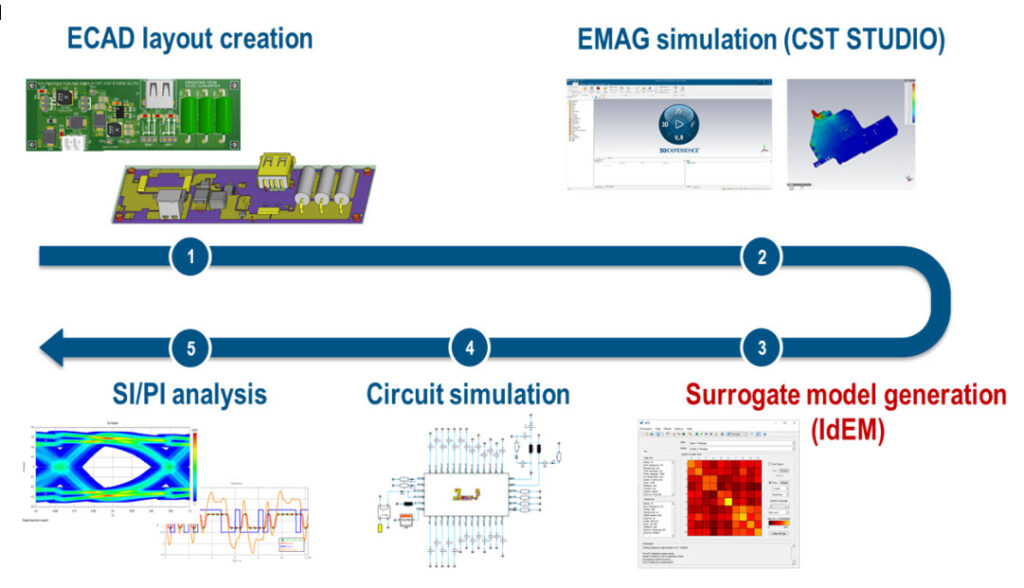This blog post covers the role of circuit and 3D field simulation for designing electronics, with a white paper on how to generate a SPICE circuit simulation model from S-parameters using broadband macromodeling and netlist/subcircuit extraction.
Circuit simulation versus 3D field simulation
There are two broad types of simulation that have long been used in electronic and electrical engineering. On the one hand, you have circuit simulation: this type of simulation models currents and voltages across circuit components, and is fast and powerful with the capability to model complex nonlinear components such as semiconductors. On the other hand, there is also 3D electromagnetic field simulation: this calculates the propagation of electromagnetic fields through space, and accurately captures the interaction between components that are coupled over a distance.
Traditionally, circuit simulation has been used to design printed circuit boards (PCBs), chip packages and integrated circuits, while 3D field simulation was used for radio and microwave components such as antennas. But as data rates increase, the frequencies of electronic signals are increasing too, to the point that they are now effectively microwaves. This means that they do not remain isolated within the signal lines but instead can propagate across the PCB and potentially cause interference issues and other signal integrity (SI), power integrity (PI) and electromagnetic compatibility (EMC) concerns.
Simulation can analyze these issues at the layout stage, modeling the transmission of data through the channels to identify issues. Figures such as eye diagrams and bathtub plots can be calculated, and potential mitigation approaches can be tested. However as mentioned, the full analysis of high-speed PCBs requires aspects of both circuit and 3D field simulation.
What is a macromodel?
This is where broadband macromodeling comes in. A macromodel of a component describes its electromagnetic behavior in a way that is compatible with circuit simulation, drawing on scattering parameter data calculated with 3D field simulation. Macromodeling enables SI/PI and EMC simulations of complex high-speed electronics to be carried out efficiently in order to identify and mitigate potential issues.

In order to be accurate, a macromodel needs to obey two rules:
- First, it must be passive. The law of conservation of energy means that a component can never output more power than is input. A component that violates this is both unrealistic and can cause simulation problems (since the power will increase and system will not converge).
- Secondly, it must be causal. The cause must always precede the effect in time, and the response from an interconnect should never anticipate the excitation.
Dassault Systèmes SIMULIA has a solution for broadband macromodeling, which generates high-fidelity, causal, passive macromodels, using the 3D electromagnetic simulation tool CST Studio Suite with the macromodeling module IdEM. IdEM produces SPICE (Simulation Program with Integrated Circuit Emphasis) models which can be used with any circuit simulation tool.
Learn more about macromodeling
The new Best Practices document “Combining 3D and Circuit Simulation using Broadband Macromodeling,” available on the SIMULIA Community, shows how IdEM can be used to build up macromodels of linear lumped multi-port structures such as via fields, connectors, packages, discontinuities from their input-output port responses. Join the SIMULIA Community and download the paper to find out more about the advantages of broadband macromodeling for SI/PI and EMC analysis of electronics in any SPICE simulation environment.
SIMULIA offers an advanced simulation product portfolio, including Abaqus, Isight, fe-safe, Tosca, Simpoe-Mold, SIMPACK, CST Studio Suite, XFlow, PowerFLOW, and more. The SIMULIA Community is the place to find the latest resources for SIMULIA software and to collaborate with other users. The key that unlocks the door of innovative thinking and knowledge building, the SIMULIA Community provides you with the tools you need to expand your knowledge, whenever and wherever.

